中职英语基础模块Unit6教案设计
- 格式:docx
- 大小:14.24 KB
- 文档页数:3
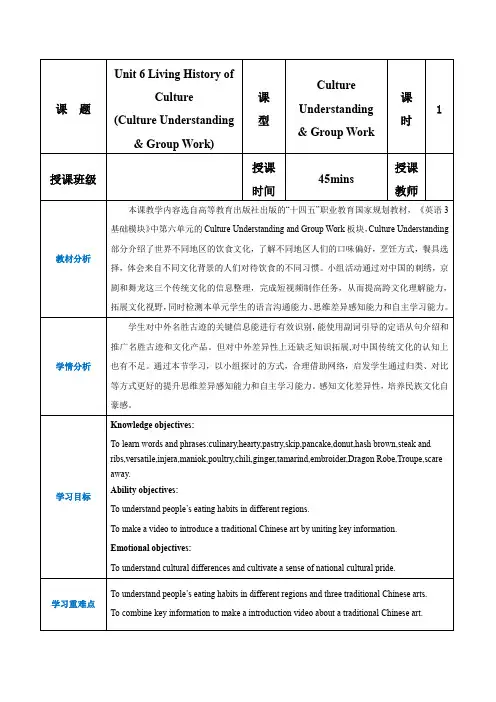
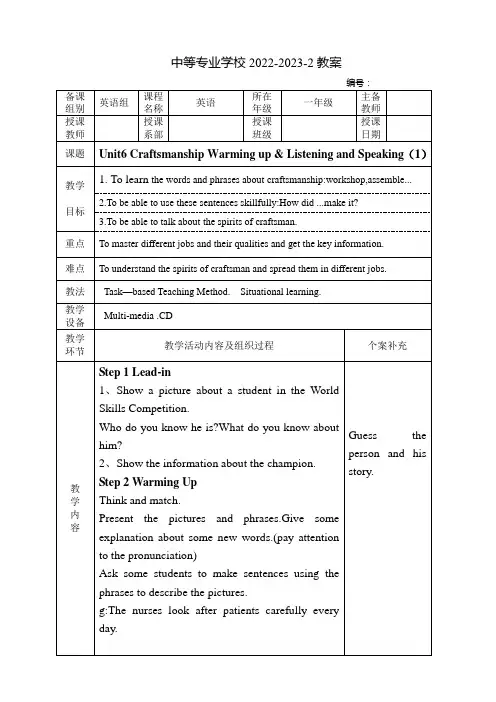
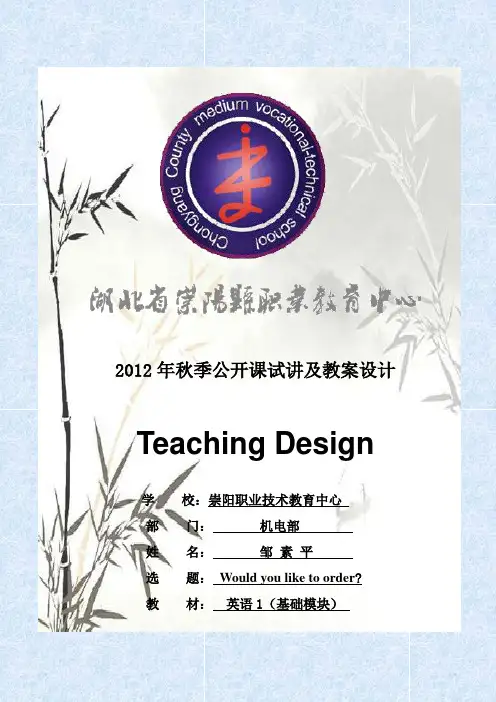
2012年秋季公开课试讲及教案设计Teaching Design学校:崇阳职业技术教育中心部门:机电部*名:***选题:Would you like to order?教材:英语1(基础模块)1.Teaching aims1.1 Knowledge aims: learning the vocabulary and structures of this unit 1.1.1 Vocabularymanager, fork, menu, customer, chopsticks, juice, coffee, beef and so on1.1.2 Grammar focusthe Comparative and Superlative form of adjectives1.2 Ability aims1.2.1 Ss are able to describe and compare different things both in written and oralEnglish;1.2.2 Ss are able to classify words about restaurant and write down the menu.1.2.3 Ss are able to improve comprehensive skills through tasks1.3 Emotional aimsSs are able to take an active part in cooperation with teammates to finish tasks;Ss are able to make choice through comparison2. Teaching key pointsGeneralizing the rules of the Comparatives and Superlatives; consolidate the words in this unit in specific context3. Possible difficultyGetting familiar with Comparatives and Superlatives according to pictures;4. Teaching and learning methods4.1 teaching methodscommunicative teaching methodaudio-visual method4.2 learning methodscommunicative strategyresource strategy5. Teaching toolsMulti-media; PPT; chalks6. Teaching proceduresStep One Review & Lead inFirst teacher will brainstorm students with a video to help them have a review what have been learnt before, and then shows two pictures to lead in the topic of this lesson.Step Two Grammar focus1.Recognize the rulesTeacher classifies in advance the table on Page 95 into five sections according to the five regular changing rules. In order to cultivate students’interest, teacher plays a cliff video. And then teacher shows tables respectively to let students generalize the rules of the different degrees of adjectives: Positive degree, Comparative degree and Superlative degree. Then teacher summarizes the usage of adjective degrees.(说明:以一个视频片段引起学生学习兴趣。
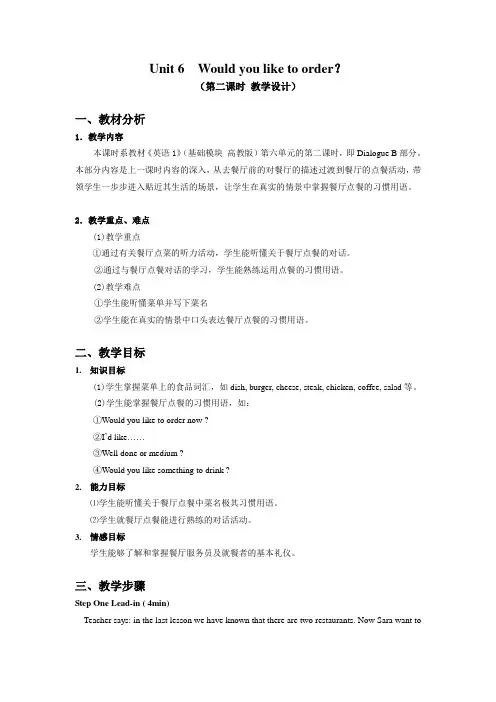
Unit 6 Would you like to order?(第二课时教学设计)一、教材分析1.教学内容本课时系教材《英语1》(基础模块高教版)第六单元的第二课时,即Dialogue B部分。
本部分内容是上一课时内容的深入,从去餐厅前的对餐厅的描述过渡到餐厅的点餐活动,带领学生一步步进入贴近其生活的场景,让学生在真实的情景中掌握餐厅点餐的习惯用语。
2.教学重点、难点(1)教学重点①通过有关餐厅点菜的听力活动,学生能听懂关于餐厅点餐的对话。
②通过与餐厅点餐对话的学习,学生能熟练运用点餐的习惯用语。
(2)教学难点①学生能听懂菜单并写下菜名②学生能在真实的情景中口头表达餐厅点餐的习惯用语。
二、教学目标1.知识目标(1)学生掌握菜单上的食品词汇,如dish, burger, cheese, steak, chicken, coffee, salad等。
(2)学生能掌握餐厅点餐的习惯用语,如:①Would you like to order now ?②I’d like……③Well done or medium ?④Would you like something to drink ?2.能力目标⑴学生能听懂关于餐厅点餐中菜名极其习惯用语。
⑵学生就餐厅点餐能进行熟练的对话活动。
3.情感目标学生能够了解和掌握餐厅服务员及就餐者的基本礼仪。
三、教学步骤Step One Lead-in ( 4min)Teacher says: in the last lesson we have known that there are two restaurants. Now Sara want togo Meiwei Restaurant. Let’s step into Meiwei restaurants with her together to order something to eat or drink today. But do you knowHow should have behavior as a customer?How should a waiter/waitree should behavior?Students work in the groups to discuss to get the right answers to the above two questions.(设计意图: 教师从上一节课内容直接过渡到本节课,开门见山。
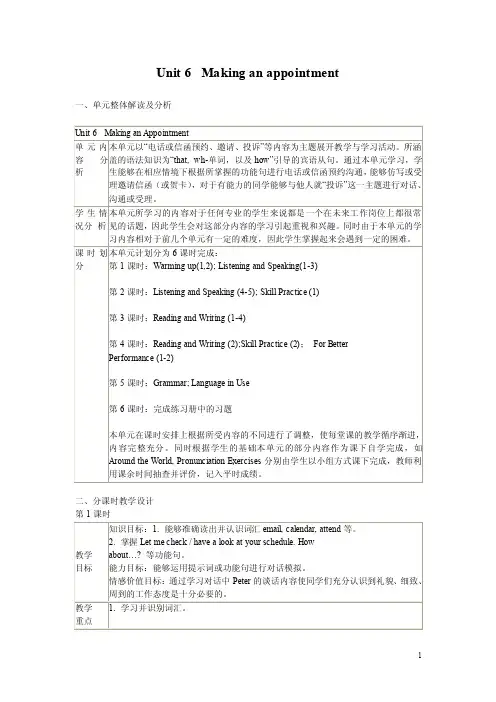
Unit 6 Making an appointment 一、单元整体解读及分析Unit 6 Making an Appointment单元内容分析本单元以“电话或信函预约、邀请、投诉”等内容为主题展开教学与学习活动。
所涵盖的语法知识为“that, wh-单词,以及how”引导的宾语从句。
通过本单元学习,学生能够在相应情境下根据所掌握的功能句进行电话或信函预约沟通,能够仿写或受理邀请信函(或贺卡),对于有能力的同学能够与他人就“投诉”这一主题进行对话、沟通或受理。
学生情况分析本单元所学习的内容对于任何专业的学生来说都是一个在未来工作岗位上都很常见的话题,因此学生会对这部分内容的学习引起重视和兴趣。
同时由于本单元的学习内容相对于前几个单元有一定的难度,因此学生掌握起来会遇到一定的困难。
课时划分本单元计划分为6课时完成:第1课时:Warming up(1,2); Listening and Speaking(1-3)第2课时:Listening and Speaking (4-5); Skill Practice (1)第3课时:Reading and Writing (1-4)第4课时:Reading and Writing (2);Skill Practice (2);For BetterPerformance (1-2)第5课时:Grammar; Language in Use第6课时:完成练习册中的习题本单元在课时安排上根据所受内容的不同进行了调整,使每堂课的教学循序渐进,内容完整充分。
同时根据学生的基础本单元的部分内容作为课下自学完成,如Around the World, Pronunciation Exercises分别由学生以小组方式课下完成,教师利用课余时间抽查并评价,记入平时成绩。
二、分课时教学设计第1课时教学目标知识目标:1. 能够准确读出并认识词汇email, calendar, attend等。
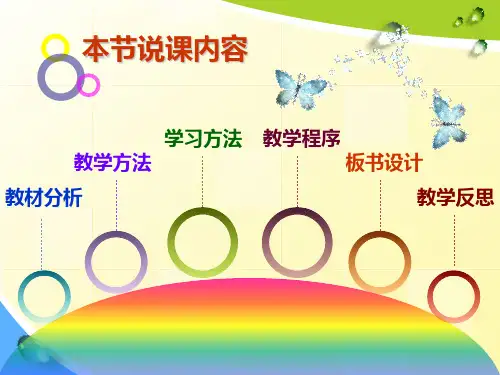
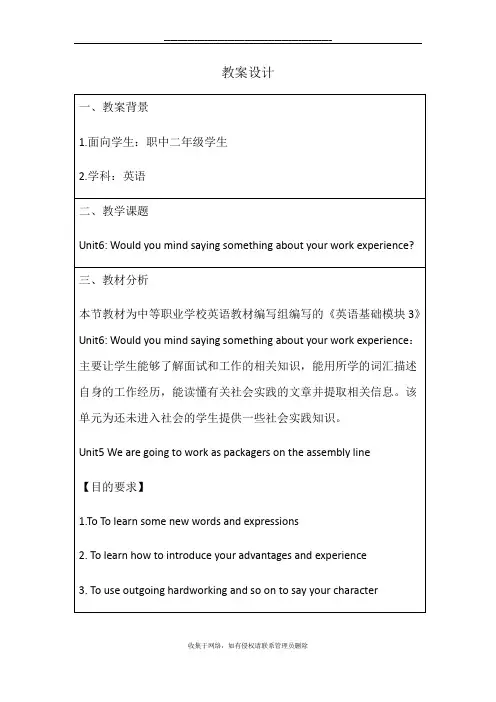
教案设计
、各分公司在接到本工作单之日起,根据配置建议开展参数优化工作,具体要求如下:
一、空闲态驻留策略
UE优先驻留FDD大带宽频点,确保UE能够获得更好的数据业务体验,优先级建议:FDD2.1 = FDD1.8 > FDD800 > TDD2.6 > CDMA
涉及主要参数:
类别功能描述涉及参数参数推荐设置
小区重选L1800/21
00同优先
级重选
小区重选优先级7 异频/异系统测量启动门限(2分贝) 9
最低接收电平(2毫瓦分贝) -64
小区重选迟滞值(分贝) 4
EUTRAN小区重选时间(秒) 1
EUTRAN异频重选时间(秒) 1
L1800到
L800重选
(低优先
级重选)
异频频点小区重选优先级7 异频/异系统测量启动门限(2分贝) 9
服务频点低优先级重选门限(2分贝) 6
异频频点低优先级重选门限(2分贝) 11
小区重选迟滞值(分贝) 5
最低接收电平(2毫瓦分贝) -64。
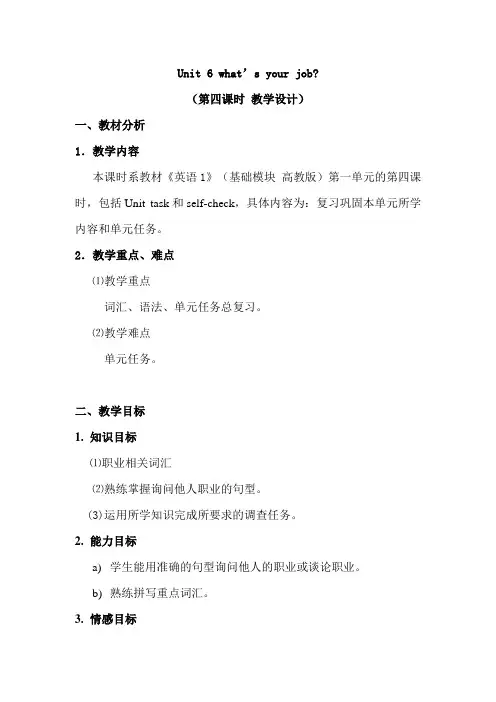
Unit 6 what’s your job?(第四课时教学设计)一、教材分析1.教学内容本课时系教材《英语1》(基础模块高教版)第一单元的第四课时,包括Unit task和self-check,具体内容为:复习巩固本单元所学内容和单元任务。
2.教学重点、难点⑴教学重点词汇、语法、单元任务总复习。
⑵教学难点单元任务。
二、教学目标1.知识目标⑴职业相关词汇⑵熟练掌握询问他人职业的句型。
(3)运用所学知识完成所要求的调查任务。
2.能力目标a)学生能用准确的句型询问他人的职业或谈论职业。
b)熟练拼写重点词汇。
3.情感目标让学生了解不同职业的特点。
了解自己的职业愿望,引导学生为自己的未来职业作出准备。
三、教学步骤Step 1 Lead-in1.Greeting.2.Revision.The teacher act out different jobs and have the students guess what they are. Ask the students to spell the words out.(设计意图:通过这一活动能帮助学生对于本单元重点词汇进行一个全面的复习并能检查的掌握情概况。
)3.RevisionShow them pictures of different jobs. Have a student come to the front facing the students. Have the student guess what is showed on the picture. He or she are supposed to use the sentence pattern: “Is he/shea …?” See who can find out the answers using the fewest questions. (设计意图:复习巩固“Is he/she a …?”。
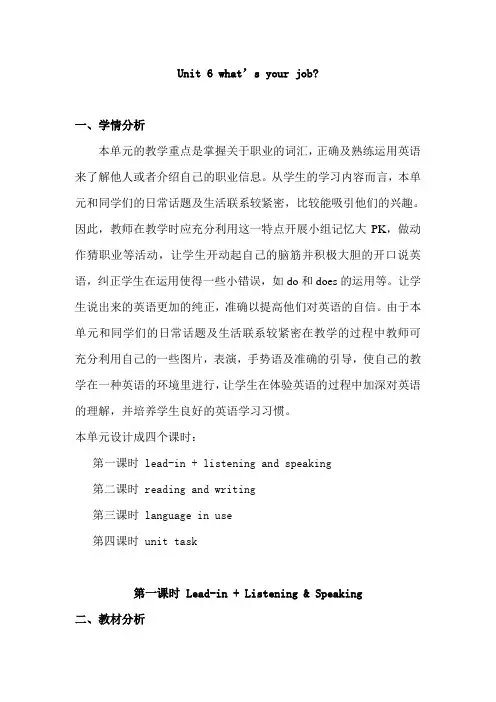
Unit 6 what’s your job?一、学情分析本单元的教学重点是掌握关于职业的词汇,正确及熟练运用英语来了解他人或者介绍自己的职业信息。
从学生的学习内容而言,本单元和同学们的日常话题及生活联系较紧密,比较能吸引他们的兴趣。
因此,教师在教学时应充分利用这一特点开展小组记忆大PK,做动作猜职业等活动,让学生开动起自己的脑筋并积极大胆的开口说英语,纠正学生在运用使得一些小错误,如do和does的运用等。
让学生说出来的英语更加的纯正,准确以提高他们对英语的自信。
由于本单元和同学们的日常话题及生活联系较紧密在教学的过程中教师可充分利用自己的一些图片,表演,手势语及准确的引导,使自己的教学在一种英语的环境里进行,让学生在体验英语的过程中加深对英语的理解,并培养学生良好的英语学习习惯。
本单元设计成四个课时:第一课时 lead-in + listening and speaking第二课时 reading and writing第三课时 language in use第四课时 unit task第一课时 Lead-in + Listening & Speaking二、教材分析1.教学内容本课时系教材《英语预备级》(基础模块)第六单元的第一课时,包括Lead-in & Listening and speaking两部分,具体内容为:职业相关词汇,听懂并掌握询问和提供个人职业信息的词汇、句型。
2.教学重点、难点⑴教学重点职业相关词汇,听懂并掌握询问和提供个人职业信息的词汇、句型⑵教学难点个人职业信息的词汇、句型三、教学目标1.知识目标⑴掌握职业相关的词汇,如manager, policeman, cleaner, teacher,doctor, nurse, waiter, secretary, babysitter, taxi driver, fireman, typist, farmer, receptionist, farmer, salesperson, cashier, worker, chef.⑵掌握提供或询问职业时所使用的句型,如:--What do you do? --I am a…--What does she do? --She is a--What’s your job? –I am a…2.能力目标⑴学生能听懂关于询问和提供职业信息的对话。
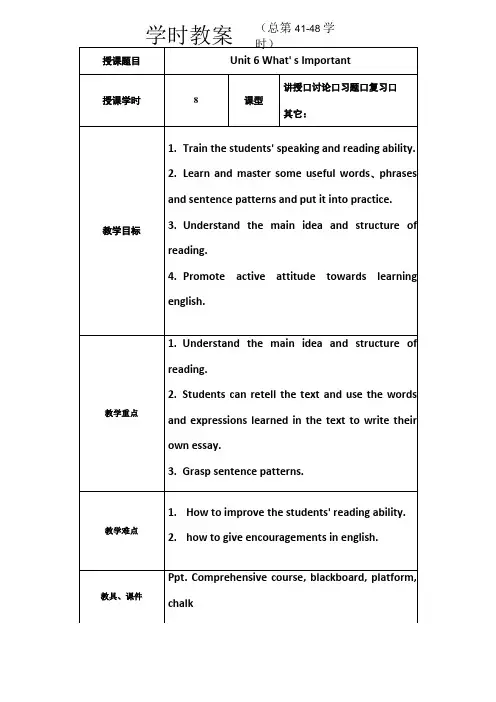
(总第41-48学1-2学时:Stepl: GreetingsGreet students cheerfully to cheer them up for this English lesson.Step2: Tell students the general arrangements of classroom teaching and learning and their tasks in this class.Step3: teaching the pronouciation of the new words and phrases and give expanlation to them.• 1. earn one, s living=make one, s living 谋生earn money=make money 赚钱• 2. remind sb. of sth.使(人)想起… remind sb. to do sth.3.unless = if ... not除非,如果不e.g. We will go shopping unless it rains. =We will goshopping if it doesn,t rain.4.instead of , instead 代替:反之,e.g. We can usestone instead of wood.It,s too hot. We didn,t goshopping. Instead, we wentswimming.重点:难点:e.g. My book is different from yours. be the same ase.g. My book is the same as yours.6.accept, receive (主观)接受;(客观)收到I received some flowers yesterday. But I didn' taccept them.7.afford to do sth.Can' t afford sth.买不起・a・Can' t afford to do sth e.g. We can' t afford ( to buy) a largehouse.8.be proud of = take pride in 为…而骄傲e.g. We are proud of you.=We take pride in you.9.on earth 到底;究竟e.g. What do you want to do on earth?10.go for a ride (开车)去兜风go for a walkStep4: Do the warming-up part.Show some pictures about money on the ppt for students, and give explanation to some words and phrases:1)Do you think money is important?2)Do you like to wear famous brand clothes?3)What do you think of life, easy or difficult?text.• 1. Why did the son dislike his father and feel unhappy?• 2. Why do young people like to wear famous brand shoes an d clothes?• 3. Can everybody in a country get rich at the same time?• 4. Is it true that all foreigners are rich?• 5. What do you think is most valuable for you?Task2 ScanningRead the text again and then find detailed information.•1.( F)The boy' s father earn much money.•2. ( T ) Young people in Italy like to wear famous brand shoes and clothes.•3. ( F) All the people can become rich at the same time.•4. ( T ) According to the text, we know that life is difficult for most people.•5. (T) Canada is known as a rich and developed country.•6. ( F ) Money is important than anything else.. Task3 Language Points and Sentence Structures1.This reminds me of Italy, when it was still a developingcountry。
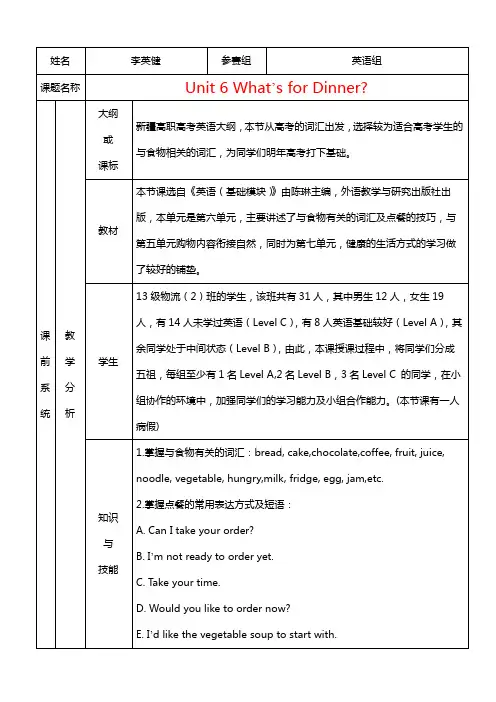
Unit 6 Home appliances一、教学目标1.掌握各种家用电器的英语名称。
2.掌握简单的借钱对话。
3.学习名词从句的用法。
4.学习辅音[f] [v] [θ] [ð] [s] [z]的发音。
二、教学用具录音机,磁带,幻灯片三、教学向导Warm—up教学要求与建议1.课前让学生预习生词和课文,课上可检查预习情况。
2.课上用幻灯片引导学生完成配图。
3.分组完成课文中的提问。
Pronunciation Practice带领学生练习辅音[f] [v] [θ] [ð] [s] [z],列举含有这些元音发音的单词,对比它们发音的不同。
Listening and Speaking一、教学重点1.学会简单的借钱对话。
2.简述移动电话情况。
二、教学建议1. 根据课文的听力材料练习对话。
2. 进行听力练习,填空。
3. 角色扮演(Role Play)(1)明确口语活动的任务,要求学生仔细阅读对话。
必要时可做简单的对话示范。
(2)学生成对活动,交换角色练习对话。
(3)教师掌握学生练习情况,解答学生提出的问题。
(4)教师和学生模拟借钱对话,示范引导学生。
(5)总结学生的表现,及时纠正学生练习中的错误之处。
三、练习参考答案A2. Listen and fill the blankswires pocket press look up useful working asking wherever B2. Answer the questions(1) No (2) No (3) C hina Mobile3. Complete the following sentences(1)find out(2)inform(3)supply(4)what4. 略5. Listen to the dialogue and answer the questions(1) by advertisement (2) on the fifth floor (3) yes (4) a refrigerator, a microwave and a stove (5) yes听力原文A2. Listen and fill in the blanks.A mobile phone has no wires and can be carried about in your pocket or your bag. It is smart. If you need to ring someone, you just press the numbers and the phone will connect you to the right number. You can take it with you wherever you go.A cordless phone also has no wires. It can be useful in the office or the factory. Imagine that you are working in an office and a customer calls you asking for some information. If you have a cordless phone, you can carry it with you and look up the information that your caller wants.B5. Listen to the dialogue and complete the form below.W: Hello. I am here to see the apartment you advertised.M: Nice to see you. Let me get the key. The apartment is on the fifth floor.W: Is there an elevator?M: Yes. It`s a self-service lift and operates twenty- four hours a day.W: This is a nice neighborhood!M: Come in, please. Here we are. Apartment 503.This is the living room with a kitchen. It is small equipped with a refrigerator, a microwave and a stove.W: Well, it`s really good. Are there central air conditioning and central heating?M: Yes. This is the bedroom I mentioned, with a closet.W: Great!Language Bank带领学生练习记忆这些日常口语,并让学生课下反复练习,定时抽查。
教案设计一、教案背景1.面向学生:职中二年级学生2.学科:英语二、教学课题Unit6: Would you mind saying something about your work experience?三、教材分析本节教材为中等职业学校英语教材编写组编写的《英语基础模块3》Unit6: Would you mind saying something about your work experience:主要让学生能够了解面试和工作的相关知识,能用所学的词汇描述自身的工作经历,能读懂有关社会实践的文章并提取相关信息。
该单元为还未进入社会的学生提供一些社会实践知识。
Unit5 We are going to work as packagers on the assembly line【目的要求】1.To To learn some new words and expressions2.To learn how to introduce your advantages and experience 3.To use outgoing hardworking and so on to say your character 4.To master new grammar 【教学内容】Text A: an applicationText B: personal stories—unusual jobsPractical Writing: finishing the applicationListening and Speaking: Unit 6Grammar【教学重点】 interview position experienced resume apply personal opportunity四、教学方法1.教学方法:情景导入法、任务教学法。
2.学习方法:小组合作学习法、探究式学习法。
五、教学过程1.Lead-in:向学生展示一个人才市场拥挤的人潮的图片,让学生将讨论并选出与图片主题相关的词语商品的问题与图片匹配。
最新中职英语基础模块授课教案:Unit6Weather中职英语基础模块授课教案Unit6 WeatherTeaching Aims:1.Knowledge object:Learn the words about the weather掌握表示天气情况的词语2.Ability objectsTalk about the weather and express their feelings.能够谈论天气,表达自己的情感3.Emotion object:Inspire students environmental protection consciousness激发学生的环保意识Teaching important and difficult points:What’s the weather like? / It’s cloudy.How’s the weather in spring?It’s warm and sunny.where are you going?I want to go sightseeing .Teaching methods:1. Oral practice to train the students' speaking ability.2. Written work to train the students' writing ability.3. Individual, pair or group work to make every student work in class.Teaching Properties:A set of multi-media equipment.Teaching procedures:Step One:Speak EnglishT: What date is it today?S: It's the ...T: What's the weather like today?S: It's ...T: How many days are there in a week?S: There are seven.T: How many months are there in a year?S: There are twelve.Step Two: Teach the new words.(1) Teach the four seasons.T: How many seasons are there in a year? There are fo ur seasons in a year.Teach the word “season”.T: Look at the picture. What season is it?It’s spring.Teach the word “spring”.T: Do you like sping?S: Yes, I do.T: I like spring, too. Because it’s warm.Teach the word “warm”. (特别注意warm 中ar 的发音)Teach the words “summer, hot, autumn ,cool, winter a nd cold” in the same way.(2)Teach the drills: Which season do you like best? I l ike … best.T: Which season do you like best?S: I like spring best.T: What’s the weather like in spring?S: It’s warm.Practice in pairs.(3) Teach the words:snowy, windy, foggy, rainy,cloudy,sunny, cool, warm.T: Which season do you like best in Suzhou?S: I like spring best.T: What’s the weather like in spring in Suzhou?S: It’s warm and rainy.Teach the word “rainy”.rainy: 有雨的rain: 雨,下雨Teach the rest words in the same way.(4) Read the new words after the tape.Step Three: Teach the new drills.(1) T: Which season do you like best?S: I like spring best.T: Why?S: Because it’s warm and windy. I can fly the kite.Teach the word: why, because(2) Ask and answer.(3) Practice in pairs.(4) Open the books and read Part C.Practice in pairs and then ask some of the students to make the dialogue.Step Four:Homework.(1)Copy the new words.(2) Do the exercises in part C.(3)Recite the new text.Step Five:SummaryNew words:warm, hot, cold, cool, fineGrammar:名词变形容词rain—rain y, wind—wind y, sun—sunny,snow—snowy cloud—cloudySentences:What’s the weather like? / It’s cloudy.How’s the weather in spring?It’s warm and sunny.where are you going?I want to go sightseeing .Blackboard DesignUnit 5 The seasonsspring warm rainy windy summer hot sunny rainy autumn cool sunny windy winter cold snowy cloudyWhich season do you like best?I like…best.Why?Because it’s … I can…Teaching postscript:。
Unit6 WeatherPeriod1 New words and Warming-up 1.Knowledge aims:1): Read and learn the new words.2): Useful expressions and the difficult sentences:——What’s the weather like today?——It’s_______.2. Ability aims:1): Get the students to learn about the new words2): Improve the Ss’ speaking ability.3. Emotional aim:Enable the Ss’ to talk about something about weather 4、Teaching key points:1. Master the .key words and useful expressions.2. Get the Ss’ to know how to say weather.5、Teaching difficult points:1. Read and recite the new words.2. Read and understand some information about seasons Part6、Teaching methods:1. Task- based teaching and learning.2. Reading and speakingPart7、Teaching aids:the multimedia computer and the general teaching tools.8、Teaching steps:Step 1.GreetingsStep2.New words1)Let students read the new words by themselves.2)Read the new words before class.3)Let students read the new words after record.4)Let students read the new words after teacher.5)Let students read the new words again.Step3: Warming-up and lead-in1) ——What’s the weather like today?——It’s__fine/ cloudy/ cool/hot/ rainy/ snowy/ windy_____.2).How many seasons are there in a year?3).Which season is cool and windy?4).Which season is the hottest season?5).Which season is the harvest time?Step4 Practice——What’s the weather like today?——It’s__fine/ cloudy/ cool/hot/ rainy/ snowy/ windy_____. Step5 SummaryIn this lesson, we learn the new words of this lesson. We also knew something about weather .Step6 Homework1) Copy the new words2) Preview the next lessonStep7 Blackboard design:Unit 6 WeatherPeriod1 New words and Warming-u pStep8、Teaching Reflection(教学反思):Period2 -3 ReadingSeasonsKnowledge aims:1): Read the text seasons.2): Read and understand the text3) Find and understand the useful expressions and the difficult sentences.:2. Ability aims:1): Get the students to learn about the useful expressions and the difficult sentences.2):Improve the Ss’ reading ability.3. Emotional aim:Enable the Ss’ to know how to express their ideas about seasons 4、Teaching key points:1. Master the .key phrases and useful expressions.2. Read the text and let students give their opinion about seasons. Part5、Teaching difficult points:1. How to improve the Ss’ speaking ability.2. Read and understand the text6、Teaching methods:1. Task- based teaching and learning.2. Reading and thinking.Part7、Teaching aids:the multimedia computer and the general teaching tools.Part8、Teaching steps:Step 1.Review what we have learnt in last lessonStep 2Fast-reading1) Read the text and finish the Reading Comprehension2) Read the text after the record3) Read the text and answer the questions of .the Reading Comprehension on Page46Step 3Carefully-reading:1) Read the text again and understand the text.Step 4Language points1.from…to…2.turn3.be good for4.on vacation5.stay in6.go swimming/ shopping/ skating/ skiing/7.be happy with…Step 5 SummaryIn this lesson, we learn some useful expressions and the difficultsentences of this lesson. We also knew how to express the ideas about seasons.Step6 Homework1)Do exercise about Useful words and expressions2) Preview the next lessonStep7 Blackboard design:Unit 6 Period2 -3 ReadingSeasonsStep8、Teaching Reflection(教学反思):Period 4 Grammar:Teaching aims:1.: Knowledge aim:1): Know degrees of adjectives and adverbs2. Ability aims:1): Get the students to learn about degrees of adjectives and adverbs2): Improve the Ss’ basic knowledge of English3. Emotional aim:Enable the Ss’ to know something about degrees of adjectives and adverbs and inspire the Ss’ interest in learning English.Part4、Teaching key points:1. Master the basic rules of degrees of adjectives and adverbs.Part5、Teaching difficult point:1. Know the usages of degrees of adjectives and adverbsPart6、Teaching methods:1. Task- based teaching and learning.2. Get some detailed information by thinking.Part7、Teaching aids:the multimedia computer and the general teaching tools. Part8、Teaching steps:Step 1. GreetingsStep 2 Lead-in1.Review what we have learnt in the previous lesson2.lead inStep3. ExplanationDegrees of adjectives and adverbsGood/well better bestBad/ill worse worstMany/much more mostLittle less leastStep4 PracticeDo the exercises on Page 30Step5 SummaryIn this lesson, we reviewed the numeralsStep6 Homework1)Do exercise in Grammar Focus2) Preview the next lessonStep7 Blackboard design:Unit 6 Weather ----GrammarStep9 Teaching Reflection(教学反思)Period5----Speaking Knowledge aim:1): Talk about weather.2. Ability aims:1): Get the students to learn how to say weather2):Improve the Ss’ speaking ability.3. Emotional aim:Enable the Ss’ to talk about weather4、Teaching key points:1. Get the Ss’ to know about weatherPart5、Teaching difficult points:1. How to improve the Ss’ speaking ability.2. Make a dialogue about weather6、Teaching methods:1. Task- based teaching and learning.2. Reading and thinking.Part7、Teaching aids:the multimedia computer and the general teaching tools. Part8、Teaching steps:Step 1.GreetingsStep 2. Review what we have learnt in last lesson Step 3.SpeakingSome useful expressions:Step 4.PracticeMake some dialogues.Step 5. SummaryIn this lesson, we reviewed how to talk about weather Step 7.Homework1) Preview the next lessonStep8 Blackboard design:Unit 5 Food ----SpeakingStep9 Teaching Reflection(教学反思)。